The all-electric RAV4 isn’t officially due to plug into the U.S. market until the 2012 calendar-year but recently Toyota gave us a chance to take a spin in one of the 31 prototypes built by its partner, the California-based battery car start-up, Tesla Motors.
Toyota was the first automaker to produce a hybrid-electric vehicle – though rival Honda beat it to the U.S. market by several months. Until recently, Toyota dismissed more advanced plug-ins and pure battery-electric vehicles, so the decision to launch the RAV4-EV was a significant shift in strategy. So was the decision to turn to Tesla.
While alliances have become the norm in the automotive world, Toyota has traditionally preferred going it alone, so the RAV4-EV will be a significant addition to the Japanese giant’s line-up in a variety of ways.
We headed to Southern California for our first drive, where Toyota had one of the battery cars fully charged and ready to go, to get a sense of what we can expect when the maker’s first pure electric vehicle comes to market in little more than a year.
There were some limitations, however. For one thing, we didn’t get to drive it far enough to get a clear indication of how long the battery could go between charges.
Toyota officials, however, said their “real world” tests indicate the Tesla-made lithium-ion battery in the modified RAV4 crossover will run between 80 miles and 120 miles without requiring a visit to the re-charging station — under ideal conditions. As with all battery cars, heavy use of the electric heater and blower will degrade range – sometimes significantly.
The lithium-ion batteries generate 37 kilowatt-hours, about 50% more than the LIon pack in the smaller, more aerodynamic Nissan Leaf battery-electric vehicle, or BEV. Another key difference is where Nissan has opted for air cooling the battery Tesla engineers chose to go with a more sophisticated – if costly — battery temperature management system, which they believe improves the pack’s performance under a wide range of climate conditions – and increases its life.
Toyota’s representative, however, also conceded the electric RAV4-EV is very slow to recharge. It currently takes about 18 hours to “fill up” a fully-drained pack using a conventional 120-Volt circuit — about 50% longer than GM’s Chevrolet Volt or the Nissan Leaf. That reflects the larger size of the Toyota battery. Using a Level II, 220-volt charger will halve the time you need to be plugged in — but is still slower than the competition.
Toyota representatives, however, said the company is working on reducing the charging times and the process should be quicker, even on 120 volts, by the time the RAV4-EV officially goes on sales next year.
Otherwise, the RAV4 EV should go a very long way towards proving to consumers that you really can build an electric vehicle that behaves just like an ordinary sedan, or in Toyota’s case, an ordinary hybrid.
The electric-drive power train is significantly quieter than the conventional RAV4 with an internal combustion engine. In addition, the extra weight added to the vehicle by the low-mounted battery pack actually seems to improve the overall ride and handling by making it smoother. It certainly seemed to corner better over the short test drive.
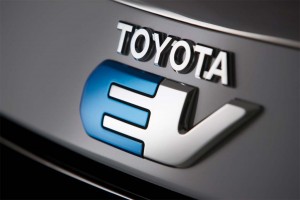
The RAV4-EV is expected to deliver performance close to that of the standard V6 crossover, Toyota claims.
In addition, the RAV4-EV will shoot from 0 to 60 miles per hour in 9 second, according to data collected by Toyota — which has equipped the test vehicles with a sophisticated black box to closely monitor their operation. That’s in line with the conventional RAV4 with an inline-four engine, though about 2 seconds slower than the bigger V6.
As with most battery-electric vehicles, acceleration is particularly strong right off the line – reflecting the fact that electric motors generate peak torque the moment they start turning, in sharp contrast to an internal combustion engine. But the Toyota crossover didn’t loose all its oomph once it got up to speed, unlike some other BEVs we have driven lately.
The RAV4-EV easily passed the pull-out and pass-a moving-vehicle- while-climbing-a -hill test, which is about as demanding a situation as you could devise given our route through the San Diego suburb of La Jolla. In fact, Toyota’s engineers maintain the acceleration of the RAV EV is excellent – under most real world circumstances matching the RAV4 V6.
Beside the smooth acceleration curve, the RAV4-EV’s brakes are quite powerful – no surprise because they are a hybrid system blending conventional hydraulic brakes and a regenerative system, much like the one used on the popular Toyota Prius. That system, which normally kicks in first, is designed to recapture energy as the car slows, pumping it back into the battery for a bit more range.
Overall, judging from the prototype offered for the test, the RAV4-EV looks as if it is going to be an impressive package, given the vehicle also retains all of the carrying capacity of the conventional RAV4.
We’ll have to wait, of course, for a longer drive in the production version, and to find out the critical specs – including price – but if our preliminary drive in a Toyota RAV4-EV is any indication, the maker should be a serious contender in a new but fast-growing battery-car segment.

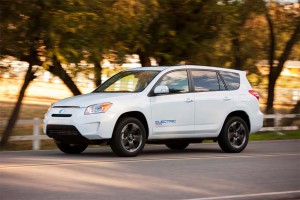
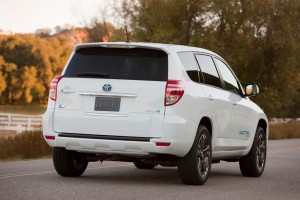
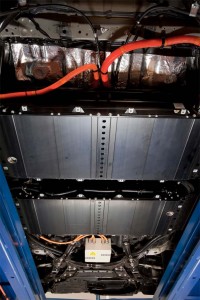
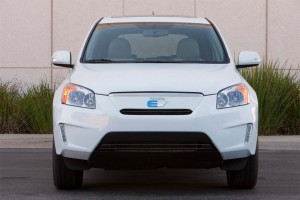
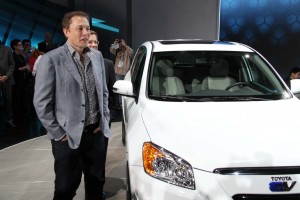
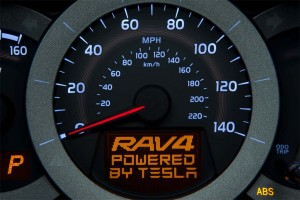
Awesome but, with that big battery pack, it’s likely to be quite expensive. Anyone have estimates for MSRP?
So far, Brian, no numbers. Yes, that’s a lot of extra battery. Even if you push down price estimates to reflect anticipated drops in the cost of LIon technology, that’s anywhere from $6,000 to $10,000 more battery (an extra 13 kWh at around $450 to $800 per kWh) compared to the Leaf. Whether Toyota will simply absorb the cost at a loss, as it did with the original Prius, remains to be seen.
Paul A. Eisenstein
Publisher, TheDetroitBureau.com